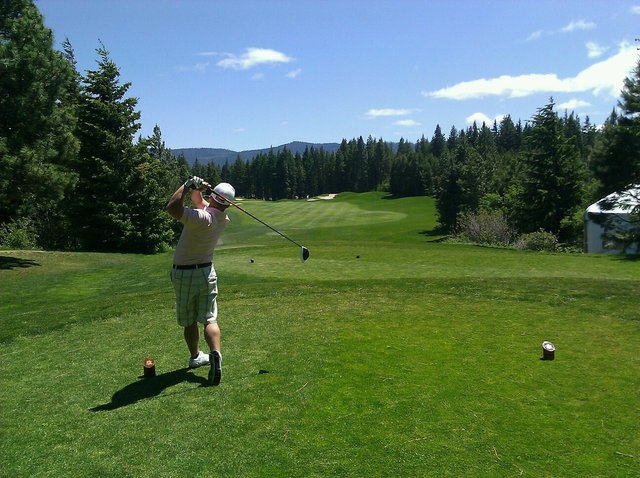
Do you want to learn how to make a solid, straightforward, and consistent fundamental golf swing? I'm sure you're aware that there are innumerable golf lessons online, as well as a lot of video golf instruction, that outline the drills golf teachers do to correct golf swing flaws, but only a few golf instructors actually get to the bottom of why most golf swing problems arise in the first place.
In this golf instruction post, I'll show you how to improve your fundamental golf swing plane so you can hit longer and straighter golf strokes more consistently, boost your golf confidence, and lower your golf scores.
The bulk of golf swing flaws caused by novice golfers may be traced back to a defective swing plane that is not aligned appropriately both to the target and to the plane angle on which it originated.
The engineers who created your golf clubs understand the importance of the swing plane, but when golfers buy equipment from a golf shop or pro shop, they usually don't get a user manual that explains how to use the clubs properly.
When you realise that the majority of expensive products you buy come with some type of instruction manual, it's kind of comical.
In any case, there is one unmistakable fact regarding developing your basic golf swing that you must understand and believe. The truth is that if you want to develop your golf game, you must swing your golf club on or very close to the original swing plane.
When you address a golf ball, the initial swing plane is the angle of the golf club you're using. Because the golf ball is positioned to the side and in front of you, every golf club, from driver to putter, is built on an inclined plane angle.
Every club in your bag has a little different plane angle, so rest it on the ground as it was designed, with the club face looking precisely at your goal, and then create your golf swing around it.
To do this effectively, you must hold the golf club lightly enough that the club face does not stray off target. Many amateur golfers I've coached at my golf school over the years clench their grips so tightly that the club face twists, resulting in golf swing alignment problems that result in slices, pulls, and even fat shots.
You're squeezing too firmly if your grip pressure is greater than five on a scale of one to ten (ten being extremely tight). Your right hand (right hand golfer) should also be positioned on the side of the grip when you hold it, such that when you open your palm up, it points straight down the goal line.
When you place your hand under the golf handle (facing the sky) or on top of it (facing the ground), you will almost certainly change the orientation of the swing plane as you swing away from the ball. Remember to base your golf swing on the golf club's design, which involves resting it on the ground and aiming it at your intended goal. When you swing your golf club away, your golf club should go through two basic but crucial stages.
Basic Swing Plane Stage 1:
- The golf club should swing directly away from the ball, without abruptly elevating upwards or moving inwards or outwards too quickly. Consider how your golf club would rest flat on a piece of cardboard at the same angle as the club, and how the club would simply go back and forth along the cardboard until the club head and shaft were parallel to the ground.
Basic Swing Plane Stage 2:
- If you moved the golf club backwards, the club head would now be higher than your hands, but still on or near the piece of card board. The grip end of the golf shaft would point exactly at the base of the card board where the golf club was originally resting as it travelled back.
From the start of the backswing to the top and into the down swing and follow-through phases, the golf shaft angle is maintained.
The best approach to learn how to accomplish this is to practise with a pitching wedge and swing it back until your left arm and golf club form an L-shaped angle. Your left arm would be horizontal, and the golf shaft would be vertical, though pointing towards the goal line.
When you swing into the follow-through, you form a horizontal arm posture with your right arm, and the golf shaft is vertical and heading down towards the target line once more.
Because it's the first stage of the whole golf swing, I call this golf stroke the 'Level 1' fundamental golf swing. Your golf swing, like a house, need a solid foundation upon which to build. You may establish the type of support your golf swing needs to effortlessly manage the distance and direction of the golf ball by practising the level one golf swing.
Keep in mind that it's all too easy to swing away without giving much thought to what you're doing. When you consider that the sole true function of a golf club is to make a sound impact, you'll see how critical it is to swing your golf club at the proper plane angle.
Even if you can't get to a driving range or practise fairway, if you practise the level one swing frequently enough, you'll notice a significant improvement in your shot-making consistency within three months.
Every good golf swing has a level one position, and yours can, too. Start practising your golf swing every day, and in the hours, days, and months ahead, you'll discover the power and purpose of the fundamental on-plane golf swing.
Are you spending countless hours trying to figure out how to improve your swing, yet you don’t seem to be seeing any results?
Go here to continue to the full version: